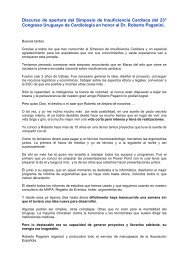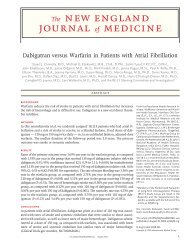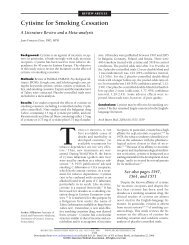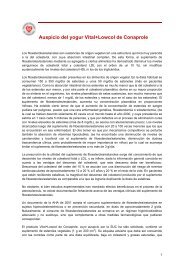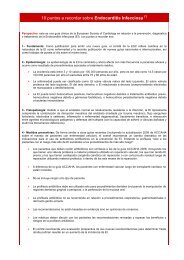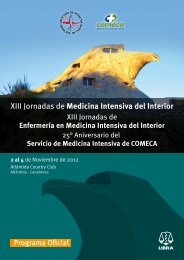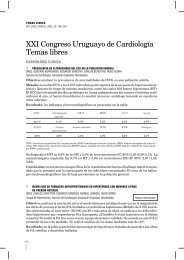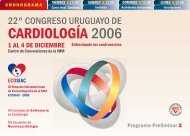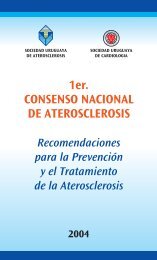Reperfusion therapy for ST elevation acute myocardial infarction in ...
Reperfusion therapy for ST elevation acute myocardial infarction in ...
Reperfusion therapy for ST elevation acute myocardial infarction in ...
Create successful ePaper yourself
Turn your PDF publications into a flip-book with our unique Google optimized e-Paper software.
950<br />
P. Widimsky et al.<br />
Figure 2 Primary PCIs per year per million <strong>in</strong>habitants <strong>in</strong> European countries. Grey colour, no data available; blue colour, countries participat<strong>in</strong>g<br />
<strong>in</strong> this study.<br />
TL and p-PCI. Both treatments can certa<strong>in</strong>ly be offered more<br />
expeditiously than was shown <strong>in</strong> this study. This should be one<br />
of the ma<strong>in</strong> goals <strong>for</strong> future improvements.<br />
Primary PCI volume per centre<br />
and per operator<br />
Primary PCI volume per centre and per operator may <strong>in</strong>fluence the<br />
outcomes, especially of <strong>ST</strong>EMI patients, where the complexity of<br />
care is more important compared with elective PCI. Un<strong>for</strong>tunately,<br />
this study was not designed to collect such data. The experience<br />
from countries, us<strong>in</strong>g primary PCI <strong>for</strong> vast majority of their<br />
<strong>ST</strong>EMI patients, shows that a population between 0.3 and 1.1<br />
million per one primary PCI (i.e. non-stop, 24/7) centre results<br />
<strong>in</strong> ca. 200–800 primary PCI procedures/year/centre. This may be<br />
considered optimal. Population per centre ,0.3 million results <strong>in</strong><br />
low numbers of <strong>ST</strong>EMI and thus the experience of the team may<br />
not be sufficient. A population significantly greater than one<br />
million results <strong>in</strong> ‘overload’ of the centre by too many <strong>in</strong>farcts<br />
(of course only if all <strong>in</strong>farcts from that region are admitted to<br />
this centre). The PCI volume per operator is probably less important<br />
than PCI volume per centre, as there are very few low volume<br />
operators <strong>in</strong> the high volume centres. The optimal case load may<br />
be anywhere between 50–100 primary PCIs/operator/year.<br />
Reimbursement<br />
In most European countries (Austria, Croatia, Czech Republic,<br />
Denmark, Germany, Greece, Hungary, Italy, Israel, Lithuania, the<br />
Netherlands, Norway, Poland, Portugal, Serbia, Slovakia, Slovenia,<br />
Sweden, and Switzerland), the reimbursement systems supports<br />
primary PCI—i.e. the PCI hospital is reimbursed adequately, the<br />
non-PCI hospital <strong>in</strong> general does not lose money by send<strong>in</strong>g<br />
patients <strong>for</strong> primary PCI and Emergency Medical Services (EMS)<br />
transfers are reimbursed. In some countries, PCI centres<br />
receive reimbursement <strong>for</strong> primary PCIs, but the small hospitals<br />
lose money when <strong>ST</strong>EMI patients are admitted <strong>in</strong>itially to PCI<br />
centres (Belgium, Bulgaria, Spa<strong>in</strong>, Turkey, and UK) or <strong>in</strong>terhospital<br />
transfer is not appropriately reimbursed (Belgium and Bulgaria). In<br />
only one country (Romania), PCIs (any) are not adequately reimbursed<br />
<strong>in</strong> general (low limits on numbers of centres and<br />
procedures).<br />
Barriers <strong>for</strong> the implementation<br />
of primary PCI <strong>in</strong> Europe<br />
Reimbursement is only rarely a real problem (see above). EMS<br />
<strong>in</strong>terhospital transport is not supported by adequate reimbursement<br />
<strong>in</strong> some countries, and <strong>in</strong> smaller districts only a s<strong>in</strong>gle<br />
EMS ambulance is <strong>in</strong> service dur<strong>in</strong>g the off-hours and cannot go<br />
Downloaded from eurheartj.ox<strong>for</strong>djournals.org by guest on April 22, 2010





